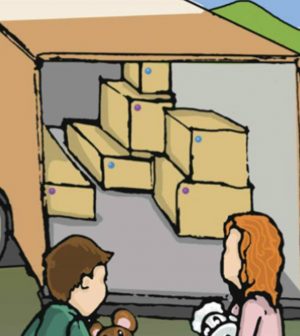- Finding Unshakable Power in a World That Wants to Pull Us ApartPosted 5 months ago
- What could a Donald Trump presidency mean for abortion rights?Posted 5 months ago
- Financial Empowerment: The Game-Changer for Women in Relationships and BeyondPosted 6 months ago
- Mental Health and Wellbeing Tips During and After PregnancyPosted 6 months ago
- Fall Renewal: Step outside your Comfort Zone & Experience Vibrant ChangePosted 7 months ago
- Women Entrepreneurs Need Support SystemsPosted 7 months ago
Emotional Bubble-Wrap for Young People Changing Homes

By Julie Etter
Moving can be hectic. It’s a contact sport. It’s physically and emotionally demanding at a time when you are supposed to still carry on the rest of life . . . jobs, dinner, rides to soccer. It’s a full-time job on top of a schedule that doesn’t have room for “another” job. So, in all of that, it’s easy to make mistakes with the kids and their involvement (or often lack-thereof) in the move. As if there weren’t enough to think about, dealing with temper tantrums, outbursts, and sometimes intangible ways of fearful expressions, by kids in the middle of a move only adds to parental stress. Below are some straightforward suggestions that parents can follow while moving children from one home to another. It all comes down to one fundamental component: involvement.
• Let their wish-list be heard. Have kids identify what they love most about their current home and what they most want to see in a new home. Although this won’t erase all anxiety, there are often simple things that can be created to help with the child’s transition (e.g., a room color, a swing set, furniture you are moving with you anyway).
• Bring the kids to see the new property. Often, and understandably so, children are left with babysitters while parents view homes. Although this is logical for the hunt, once a property is under agreement and you know where specifically you are moving, set a time to go to the house. Between inspections, measurements, etc., there should be ample times when it’s appropriate for them to come to check it out. At a minimum, this will allow their anxiety to be focused and hopefully more specifically identified than that of the unknown. This is also a good idea in respect to visiting a new school, if applicable.
• Let them pack. Putting all the kids’ stuff in a box and telling them it will be at the next mysterious place creates uneasiness over what’s happening with their stuff. In Lily and Andrew are Moving, a children’s book designed to identify and work with kids’ moving anxieties, each family member gets a “color.” The color-coded stickers are then placed on that member’s belongings/boxes for easy identification for moving location. That same color is placed on that family members’ bedroom door for ease of identification.
• Prepare yourself for extra emotional outbursts and use them as a foundation for conversation. One of the biggest complaints I get from parents is that the kids’ behavior is very poor and it’s yet another stressor during a hectic time. Try to remember that everything going on and the stress you are feeling is undoubtedly affecting them. They may not know how to articulate why. Use these attention grabbers to, well, grab your attention and talk about the move with your child.
Most of all, just understand that the kids are moving, too. So, regardless of whether it’s a positive or negative move for the family, work through their reactions just as you do in your role as parent in any other life event. Trust, though, once everything is in motion, they are far more resilient than their adult counterparts.
********
 Julie Etter is a professional, national award-winning realtor and former middle-school teacher based in Wrentham, MA. She is the author of Lily and Andrew Are Moving (Hardcover, $14.95; Kindle, $11.99), published by JT Publications, LLC.
Julie Etter is a professional, national award-winning realtor and former middle-school teacher based in Wrentham, MA. She is the author of Lily and Andrew Are Moving (Hardcover, $14.95; Kindle, $11.99), published by JT Publications, LLC.
For more information, visit www.treehousebuddies.com






